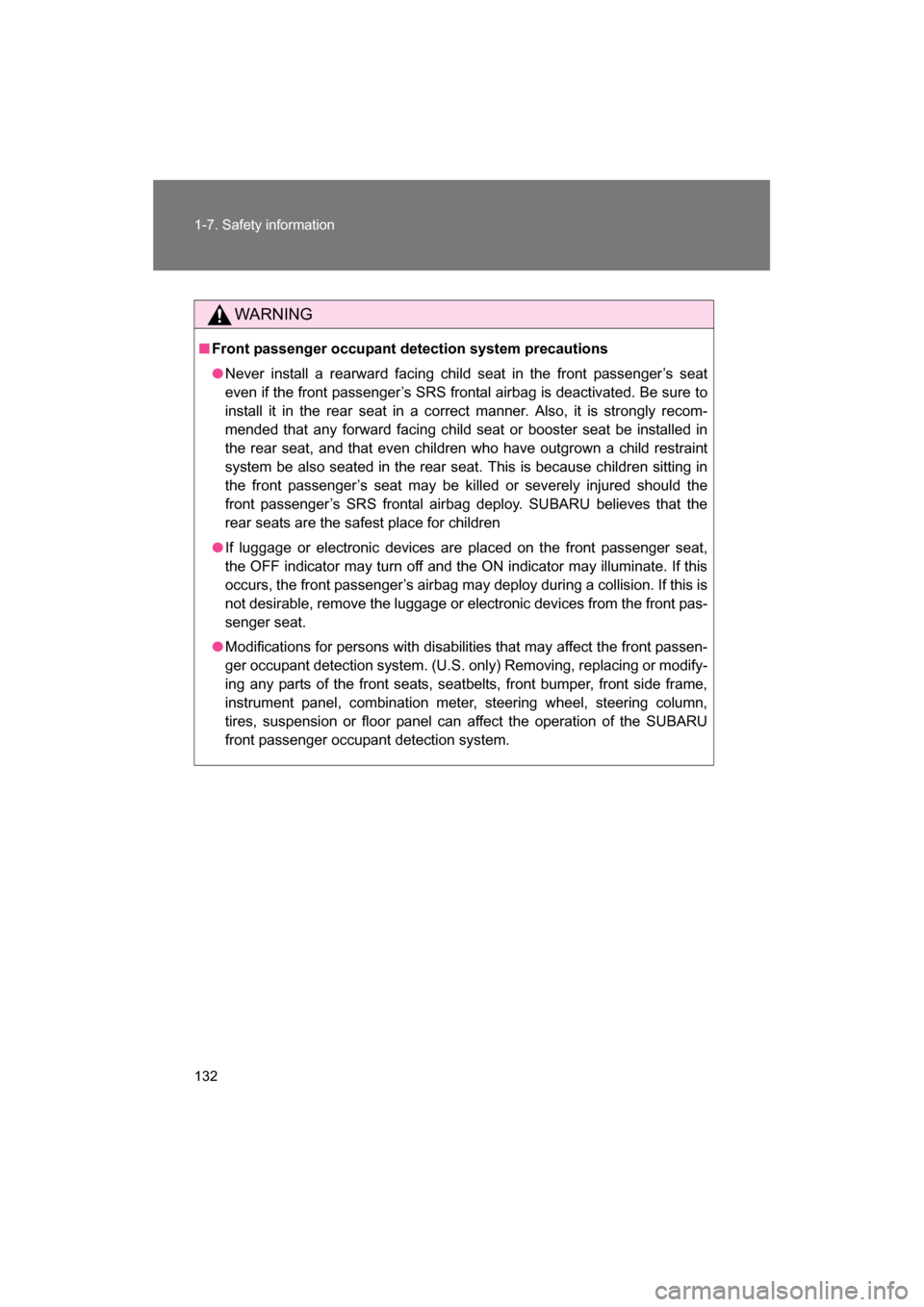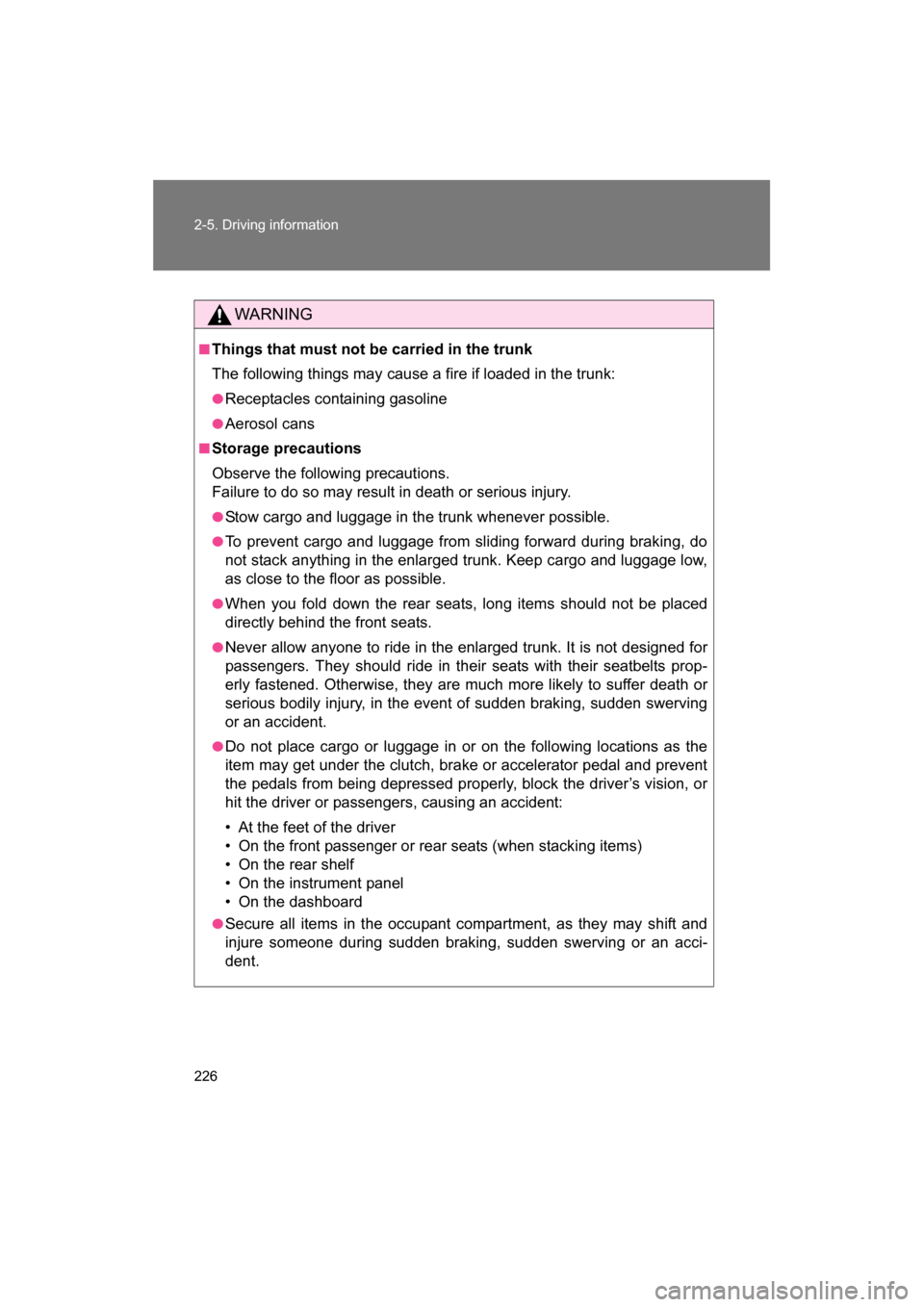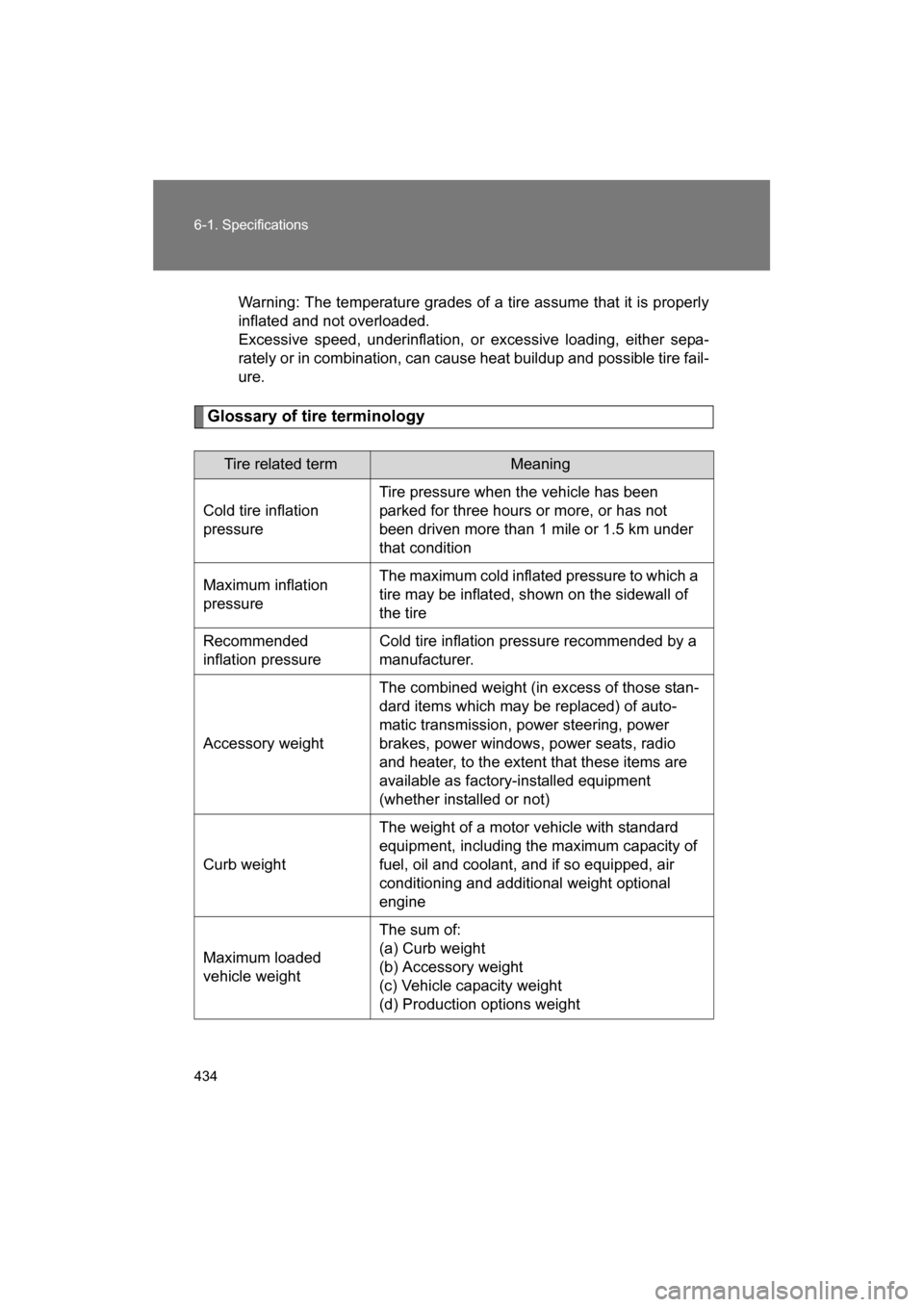Page 122 of 488

122
1-7. Safety information
●Curtain airbag module (left-hand side)
● Satellite safing sensor (under the center of the rear seats)
● Seatbelt pretensioner (driver’s side)
● Seatbelt pretensioner (front passenger’s side)
● Seatbelt buckle switch (front passenger’s side)
● Front passenger’s occupant detection system sensor
● Front passenger’s occupant detection control module
● Front passenger’s frontal airbag ON and OFF indicator
● All related wiring
WARNING
■SRS warning light
If the warning light exhibits any of the following conditions, there may be a
malfunction in the seatbelt pretensioners and/or SRS airbag system. Imme-
diately take your vehicle to your nearest SUBARU dealer to have the system
checked. Unless checked and properly repaired, the seatbelt pretensioners
and/or SRS airbag will not operate properly in the event of a collision, which
may increase the risk of injury.
●Flashing or flickering of the warning light
●No illumination of the warning light when the ignition switch is first turned
to the “ON” position.
●Continuous illumination of the warning light
●Illumination of the warning light while driving
Page 132 of 488

132
1-7. Safety information
WARNING
■Front passenger occupant detection system precautions
●Never install a rearward facing child seat in the front passenger’s seat
even if the front passenger’s SRS frontal airbag is deactivated. Be sure to
install it in the rear seat in a correct manner. Also, it is strongly recom-
mended that any forward facing child seat or booster seat be installed in
the rear seat, and that even children who have outgrown a child restraint
system be also seated in the rear seat. This is because children sitting in
the front passenger’s seat may be killed or severely injured should the
front passenger’s SRS frontal airbag deploy. SUBARU believes that the
rear seats are the safest place for children
●If luggage or electronic devices are placed on the front passenger seat,
the OFF indicator may turn off and the ON indicator may illuminate. If this
occurs, the front passenger’s airbag may deploy during a collision. If this is
not desirable, remove the luggage or electronic devices from the front pas-
senger seat.
●Modifications for persons wi th disabilities that may affect the front passen-
ger occupant detection system. (U.S. onl y) Removing, replacing or modify-
ing any parts of the front seats, seatbelts, front bumper, front side frame,
instrument panel, combination meter, steering wheel, steering column,
tires, suspension or floor panel can affect the operation of the SUBARU
front passenger occupant detection system.
Page 137 of 488
137
1
1-7. Safety information
Before driving
Installing child restraints
Follow the child restraint system ma
nufacturer's instructions. Firmly
secure child restraints to the rear seats using the LATCH anchors or
a seatbelt. Attach the top tether strap when installing a child
restraint.
The lap/shoulder belt can be used if your child restraint system is
not compatible with the LATCH (Lower Anchors and Tethers for Chil-
dren) system.
Child restraint LATCH anchorsLATCH anchors are provided
for both rear seats. (Buttons
displaying the location of the
anchors are attached to the
seats.)
Seatbelts equipped with a
child restraint locking mecha-
nism (ALR/ELR belts except
driver’s seatbelt) ( →P. 5 8 )
Anchor bracket (for top tether
strap) Anchor brackets are provided
for both rear seats.
Page 204 of 488
204
2-3. Operating the lights and windshield wipers
Manual headlight leveling dialThe level of the headlights can be adjusted according to the number
of passengers and the loading condition of the vehicle. Raises the level of the head-
lights
Lowers the level of the head-
lights
■Guide to dial settings
Occupancy and luggage load conditionsDial positionOccupantsLuggage load
Driver None 0
Driver and front pas- senger None 0
All seats occupied None 1
All seats occupied Full luggage loading 1 Driver Full luggage loading 2
Page 226 of 488

226
2-5. Driving information
WARNING
■Things that must not be carried in the trunk
The following things may cause a fire if loaded in the trunk:
●Receptacles containing gasoline
●Aerosol cans
■Storage precautions
Observe the following precautions.
Failure to do so may result in death or serious injury.
●Stow cargo and luggage in the trunk whenever possible.
●To prevent cargo and luggage from sliding forward during braking, do
not stack anything in the enlarged trunk. Keep cargo and luggage low,
as close to the floor as possible.
●When you fold down the rear seats, long items should not be placed
directly behind the front seats.
●Never allow anyone to ride in the enlarged trunk. It is not designed for
passengers. They should ride in their seats with their seatbelts prop-
erly fastened. Otherwise, they are much more likely to suffer death or
serious bodily injury, in the event of sudden braking, sudden swerving
or an accident.
●Do not place cargo or luggage in or on the following locations as the
item may get under the clutch, brake or accelerator pedal and prevent
the pedals from being depressed properly, block the driver’s vision, or
hit the driver or passengers, causing an accident:
Page 244 of 488
244
3-1. Using the air conditioning system and defogger
Using the automatic air conditioning systemPress .
The dehumidification function begins to operate. Air outlets,
fan speed, air inlet control and the air conditioner compressor
are automatically adjusted according to the temperature set-
ting.
Turn temperature control dial clockwise to increases the tem-
perature and turn temperature control dial counterclockwise to
decreases the temperature on the driver’s side.
When is pressed (the indicator on is on) or the pas-
senger’s side temperature control dial is turned, the temperature for
the driver and passenger seats can be adjusted separately.
STEP 1
STEP 2
Page 268 of 488
268
3-5. Other interior features
Seat heaters∗
■The seat heaters can be used when
The push-button ignition switch is in “ON” mode.
■When not in use
Turn the seat heater off. The indicator light goes off.
∗
: If equipped
Press the switch to warm the
seats.
The indicator light comes on
when a seat heater is turnedon.
Rapid heating
Normal heating
Page 434 of 488

434
6-1. Specifications
Warning: The temperature grades of a tire assume that it is properly
inflated and not overloaded.
Excessive speed, underinflation, or excessive loading, either sepa-
rately or in combination, can cause heat buildup and possible tire fail-
ure.
Glossary of tire terminology
Tire related termMeaning
Cold tire inflation
pressure Tire pressure when the vehicle has been
parked for three hours or more, or has not
been driven more than 1 mile or 1.5 km under
that condition
Maximum inflation
pressure The maximum cold inflated pressure to which a
tire may be inflated, shown on the sidewall of
the tire
Recommended
inflation pressure Cold tire inflation pressure recommended by a
manufacturer.
Accessory weight The combined weight (in excess of those stan-
dard items which may be replaced) of auto-
matic transmission, power steering, power
brakes, power windows, power seats, radio
and heater, to the extent that these items are
available as factory-installed equipment
(whether installed or not)
Curb weight The weight of a motor vehicle with standard
equipment, including the maximum capacity of
fuel, oil and coolant, and if so equipped, air
conditioning and additional weight optional
engine
Maximum loaded
vehicle weight The sum of:
(a) Curb weight
(b) Accessory weight
(c) Vehicle capacity weight
(d) Production options weight